oil YAMAHA XL 1200 2001 Owners Manual
[x] Cancel search | Manufacturer: YAMAHA, Model Year: 2001, Model line: XL 1200, Model: YAMAHA XL 1200 2001Pages: 131, PDF Size: 8.12 MB
Page 23 of 131
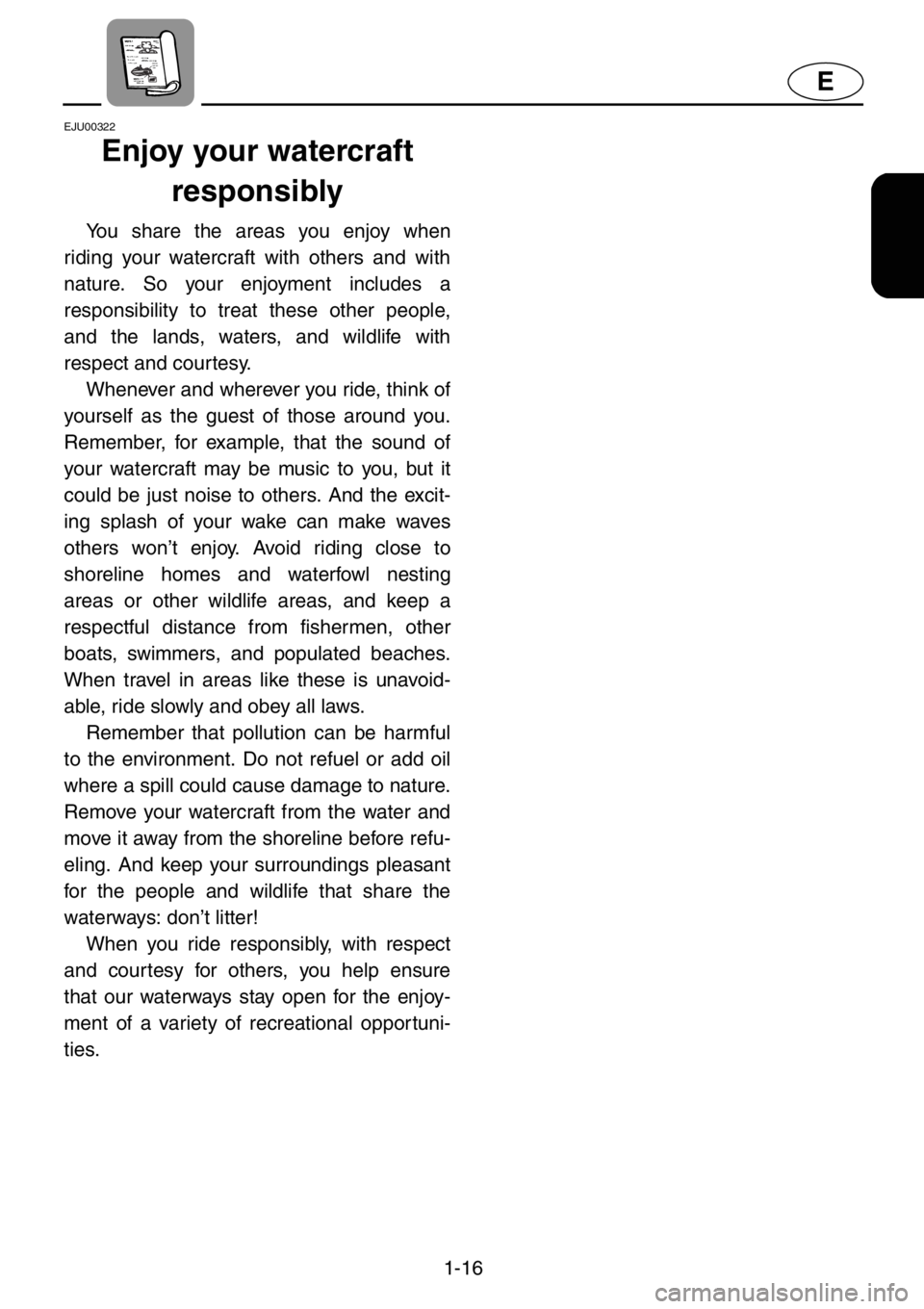
1-16
E
EJU00322
Enjoy your watercraft
responsibly
You share the areas you enjoy when
riding your watercraft with others and with
nature. So your enjoyment includes a
responsibility to treat these other people,
and the lands, waters, and wildlife with
respect and courtesy.
Whenever and wherever you ride, think of
yourself as the guest of those around you.
Remember, for example, that the sound of
your watercraft may be music to you, but it
could be just noise to others. And the excit-
ing splash of your wake can make waves
others won’t enjoy. Avoid riding close to
shoreline homes and waterfowl nesting
areas or other wildlife areas, and keep a
respectful distance from fishermen, other
boats, swimmers, and populated beaches.
When travel in areas like these is unavoid-
able, ride slowly and obey all laws.
Remember that pollution can be harmful
to the environment. Do not refuel or add oil
where a spill could cause damage to nature.
Remove your watercraft from the water and
move it away from the shoreline before refu-
eling. And keep your surroundings pleasant
for the people and wildlife that share the
waterways: don’t litter!
When you ride responsibly, with respect
and courtesy for others, you help ensure
that our waterways stay open for the enjoy-
ment of a variety of recreational opportuni-
ties.
Page 25 of 131
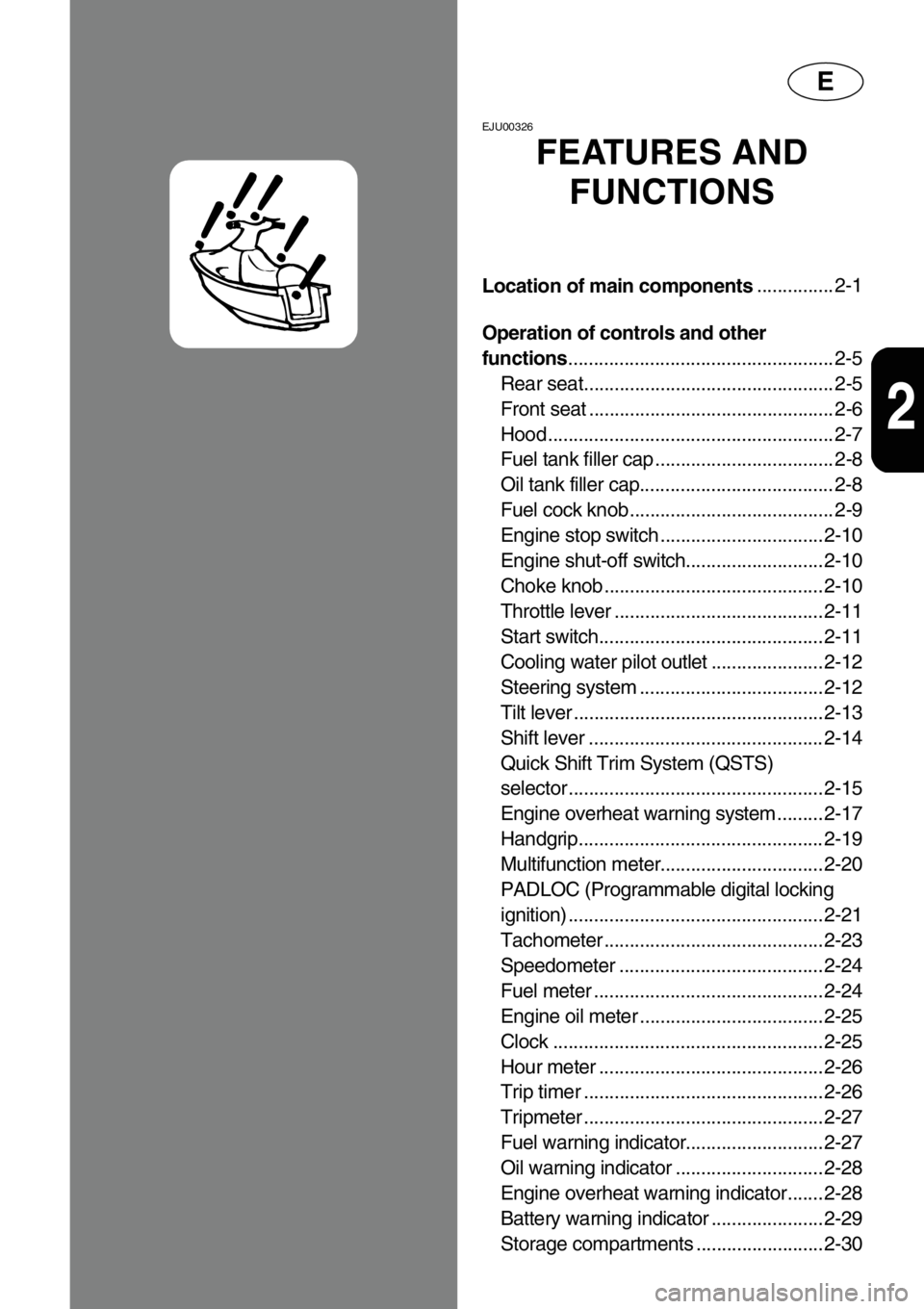
E
2
EJU00326
FEATURES AND
FUNCTIONS
Location of main components............... 2-1
Operation of controls and other
functions.................................................... 2-5
Rear seat................................................. 2-5
Front seat ................................................ 2-6
Hood ........................................................ 2-7
Fuel tank filler cap ................................... 2-8
Oil tank filler cap...................................... 2-8
Fuel cock knob........................................ 2-9
Engine stop switch ................................ 2-10
Engine shut-off switch........................... 2-10
Choke knob ........................................... 2-10
Throttle lever ......................................... 2-11
Start switch............................................ 2-11
Cooling water pilot outlet ...................... 2-12
Steering system .................................... 2-12
Tilt lever ................................................. 2-13
Shift lever .............................................. 2-14
Quick Shift Trim System (QSTS)
selector .................................................. 2-15
Engine overheat warning system ......... 2-17
Handgrip................................................ 2-19
Multifunction meter................................ 2-20
PADLOC (Programmable digital locking
ignition) .................................................. 2-21
Tachometer ........................................... 2-23
Speedometer ........................................ 2-24
Fuel meter ............................................. 2-24
Engine oil meter .................................... 2-25
Clock ..................................................... 2-25
Hour meter ............................................ 2-26
Trip timer ............................................... 2-26
Tripmeter ............................................... 2-27
Fuel warning indicator........................... 2-27
Oil warning indicator ............................. 2-28
Engine overheat warning indicator....... 2-28
Battery warning indicator ...................... 2-29
Storage compartments ......................... 2-30
Page 29 of 131
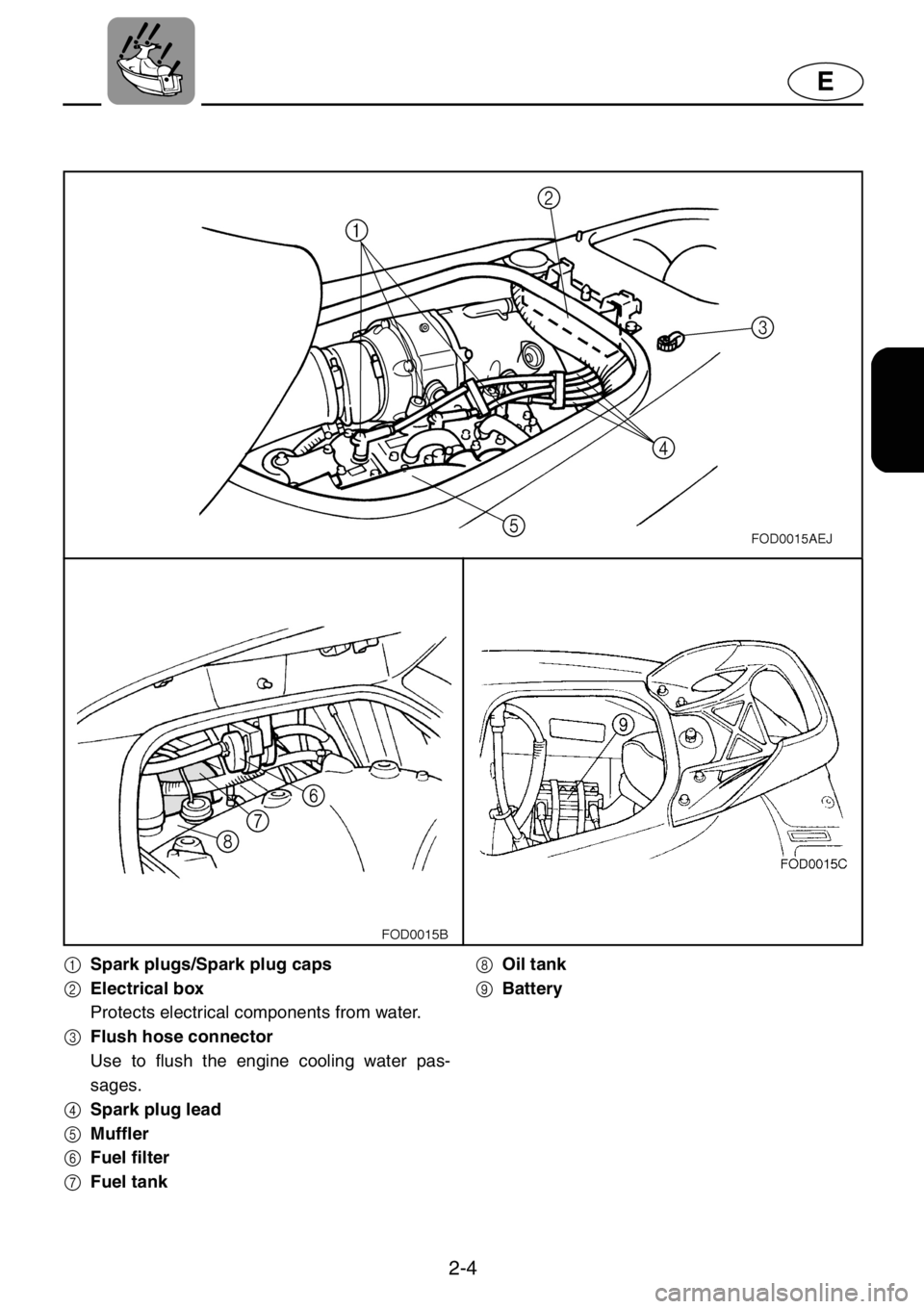
2-4
E
1Spark plugs/Spark plug caps
2Electrical box
Protects electrical components from water.
3Flush hose connector
Use to flush the engine cooling water pas-
sages.
4Spark plug lead
5Muffler
6Fuel filter
7Fuel tank8Oil tank
9Battery
Page 33 of 131
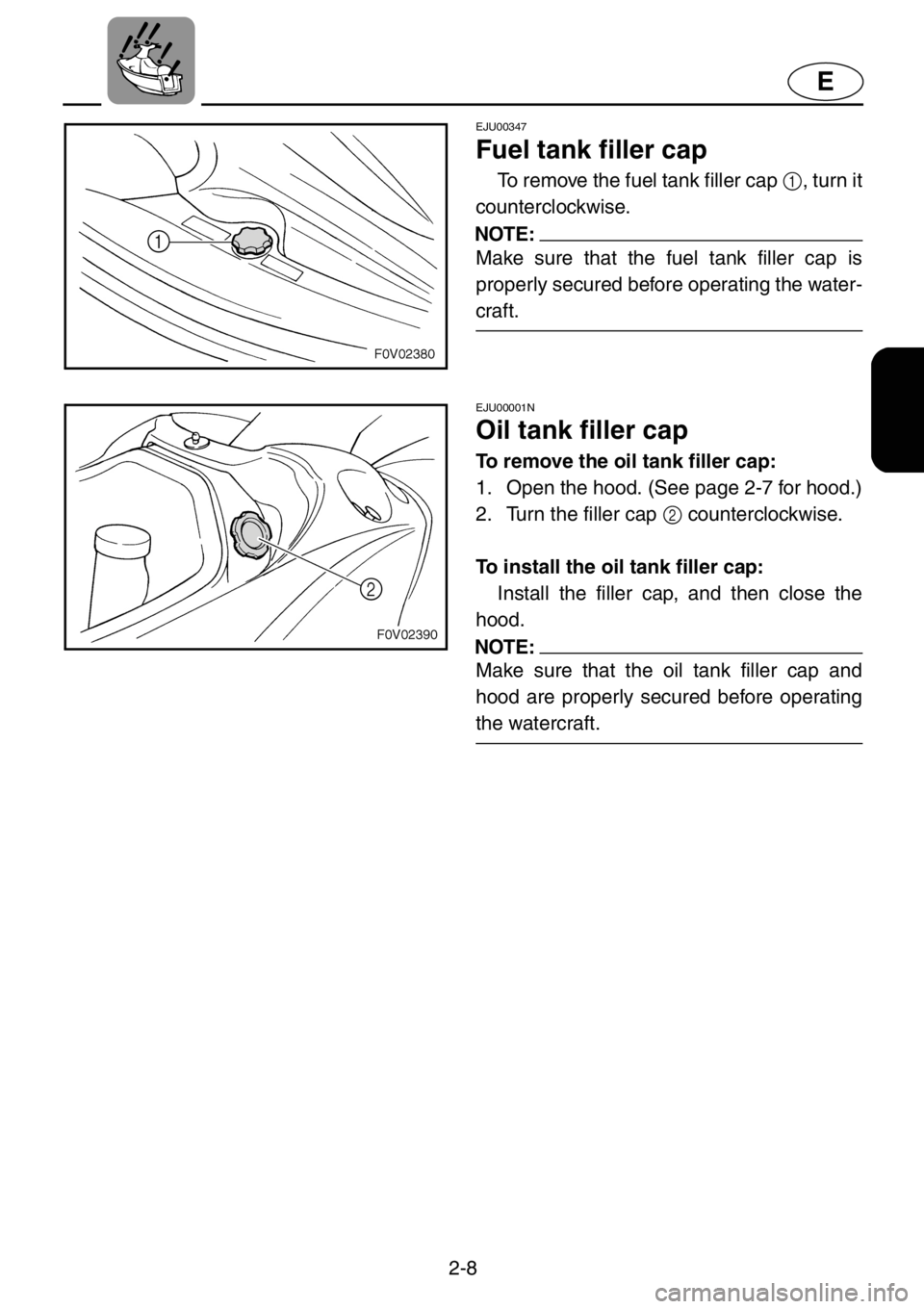
2-8
E
EJU00347
Fuel tank filler cap
To remove the fuel tank filler cap 1, turn it
counterclockwise.
NOTE:
Make sure that the fuel tank filler cap is
properly secured before operating the water-
craft.
EJU00001N
Oil tank filler cap
To remove the oil tank filler cap:
1. Open the hood. (See page 2-7 for hood.)
2. Turn the filler cap 2 counterclockwise.
To install the oil tank filler cap:
Install the filler cap, and then close the
hood.
NOTE:
Make sure that the oil tank filler cap and
hood are properly secured before operating
the watercraft.
Page 45 of 131
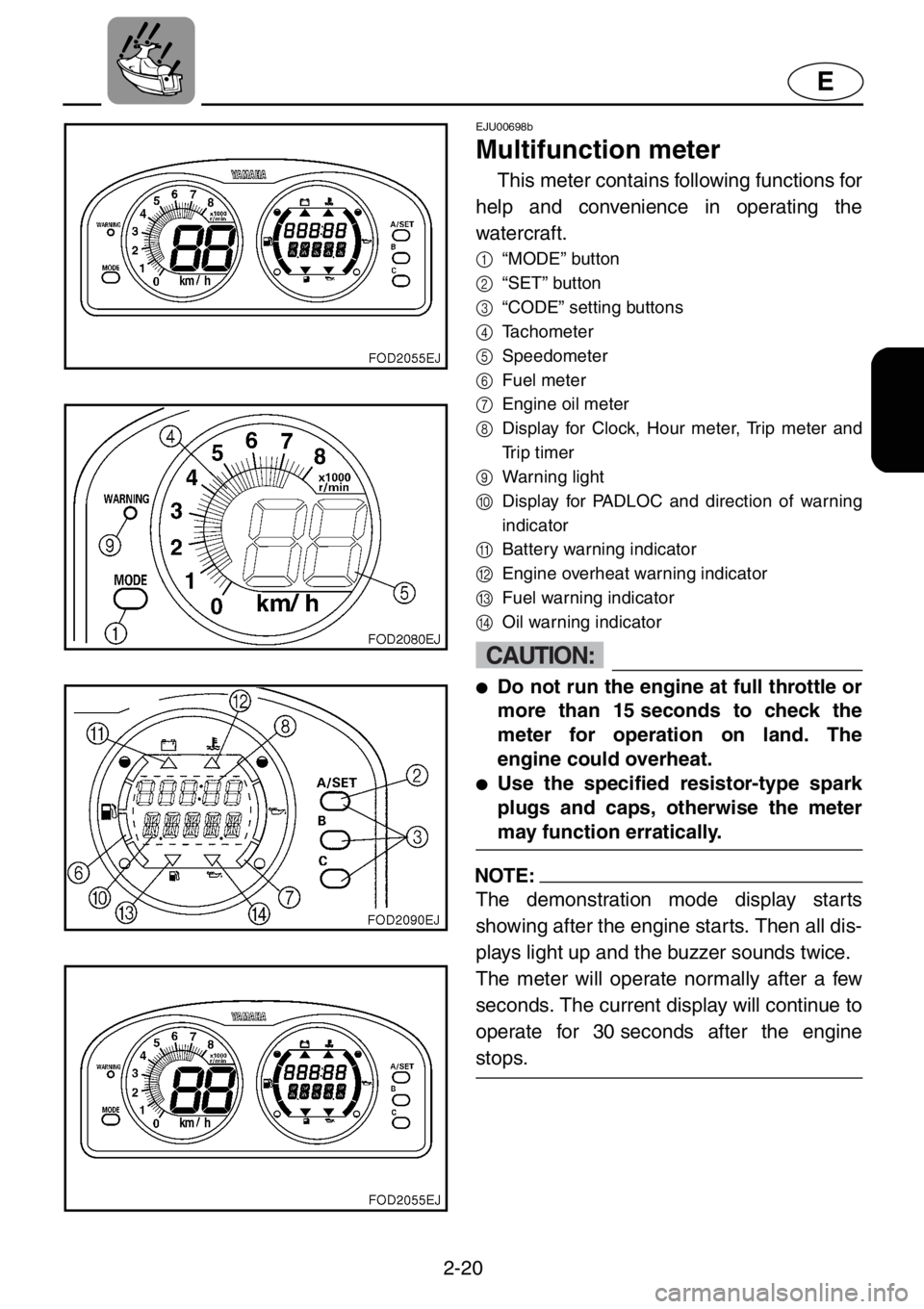
2-20
E
EJU00698b
Multifunction meter
This meter contains following functions for
help and convenience in operating the
watercraft.
1
“MODE” button
2
“SET” button
3
“CODE” setting buttons
4
Tachometer
5
Speedometer
6
Fuel meter
7
Engine oil meter
8
Display for Clock, Hour meter, Trip meter and
Trip timer
9
Warning light
0
Display for PADLOC and direction of warning
indicator
A
Battery warning indicator
B
Engine overheat warning indicator
C
Fuel warning indicator
D
Oil warning indicator
CAUTION:
●Do not run the engine at full throttle or
more than 15 seconds to check the
meter for operation on land. The
engine could overheat.
●Use the specified resistor-type spark
plugs and caps, otherwise the meter
may function erratically.
NOTE:
The demonstration mode display starts
showing after the engine starts. Then all dis-
plays light up and the buzzer sounds twice.
The meter will operate normally after a few
seconds. The current display will continue to
operate for 30 seconds after the engine
stops.
Page 50 of 131
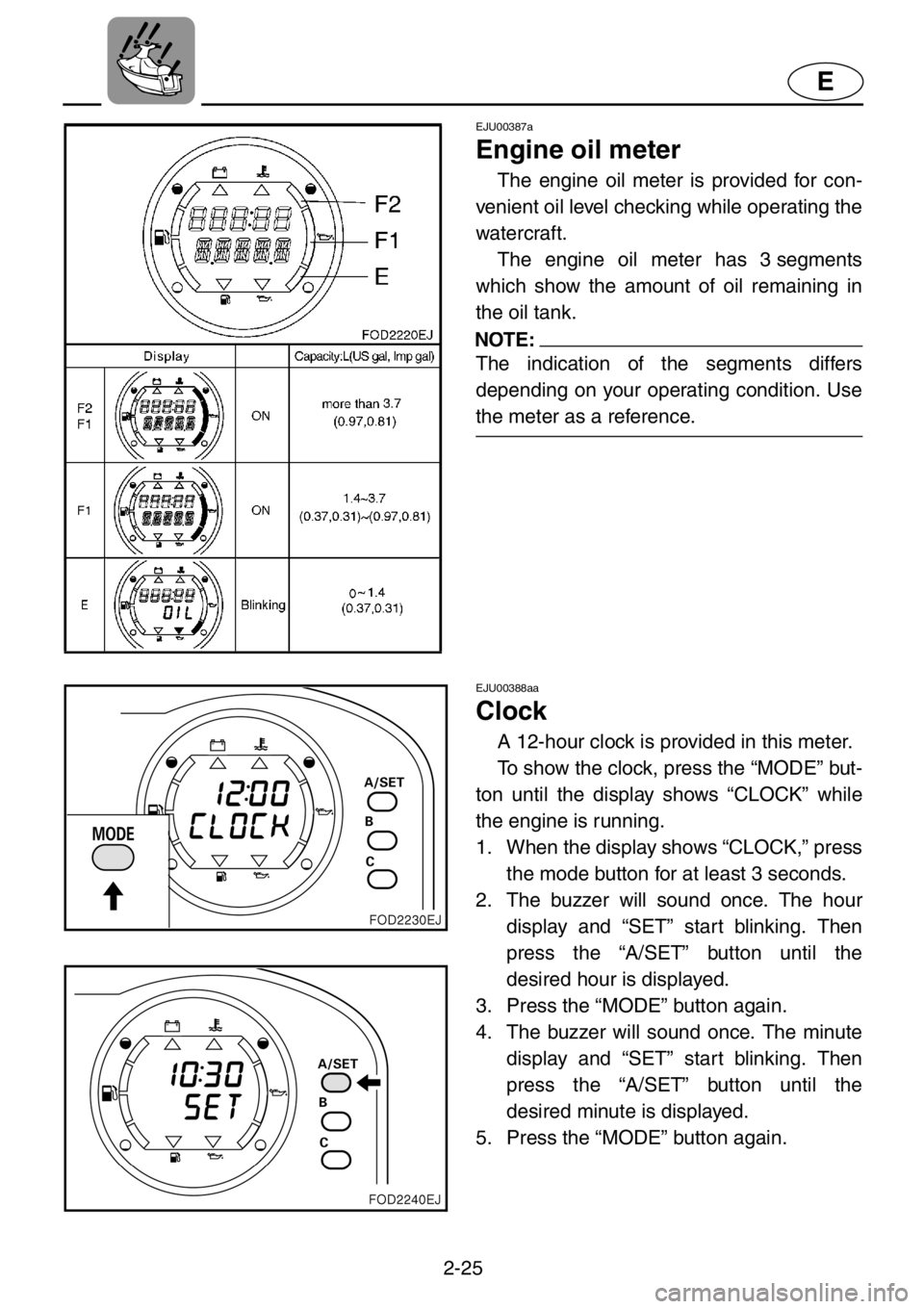
2-25
E
EJU00387a
Engine oil meter
The engine oil meter is provided for con-
venient oil level checking while operating the
watercraft.
The engine oil meter has 3 segments
which show the amount of oil remaining in
the oil tank.
NOTE:
The indication of the segments differs
depending on your operating condition. Use
the meter as a reference.
EJU00388aa
Clock
A 12-hour clock is provided in this meter.
To show the clock, press the “MODE” but-
ton until the display shows “CLOCK” while
the engine is running.
1. When the display shows “CLOCK,” press
the mode button for at least 3 seconds.
2. The buzzer will sound once. The hour
display and “SET” start blinking. Then
press the “A/SET” button until the
desired hour is displayed.
3. Press the “MODE” button again.
4. The buzzer will sound once. The minute
display and “SET” start blinking. Then
press the “A/SET” button until the
desired minute is displayed.
5. Press the “MODE” button again.
Page 53 of 131
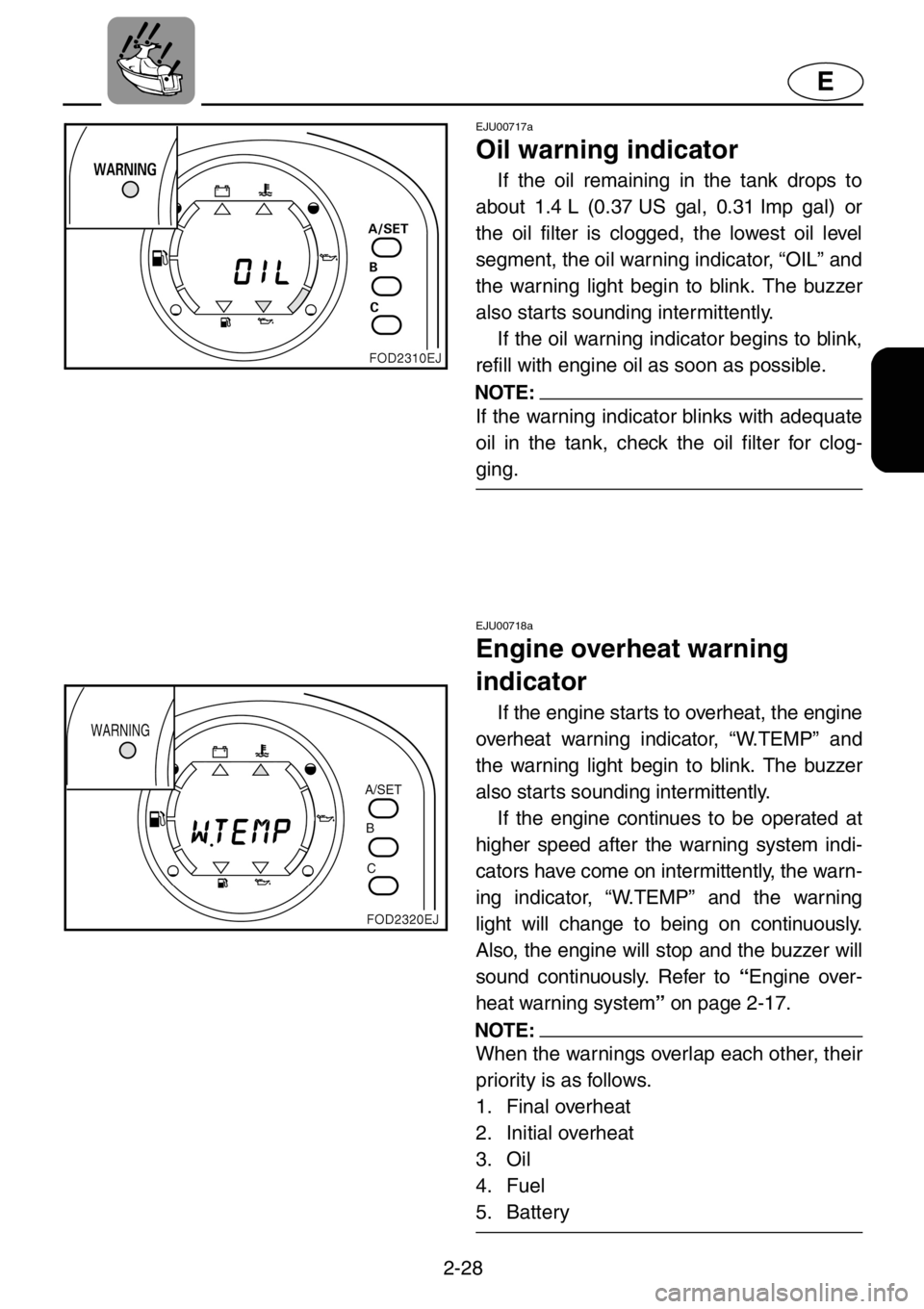
2-28
E
EJU00717a
Oil warning indicator
If the oil remaining in the tank drops to
about 1.4 L (0.37 US gal, 0.31 Imp gal) or
the oil filter is clogged, the lowest oil level
segment, the oil warning indicator, “OIL” and
the warning light begin to blink. The buzzer
also starts sounding intermittently.
If the oil warning indicator begins to blink,
refill with engine oil as soon as possible.
NOTE:
If the warning indicator blinks with adequate
oil in the tank, check the oil filter for clog-
ging.
EJU00718a
Engine overheat warning
indicator
If the engine starts to overheat, the engine
overheat warning indicator, “W.TEMP” and
the warning light begin to blink. The buzzer
also starts sounding intermittently.
If the engine continues to be operated at
higher speed after the warning system indi-
cators have come on intermittently, the warn-
ing indicator, “W.TEMP” and the warning
light will change to being on continuously.
Also, the engine will stop and the buzzer will
sound continuously. Refer to “Engine over-
heat warning system” on page 2-17.
NOTE:
When the warnings overlap each other, their
priority is as follows.
1. Final overheat
2. Initial overheat
3. Oil
4. Fuel
5. Battery
Page 57 of 131
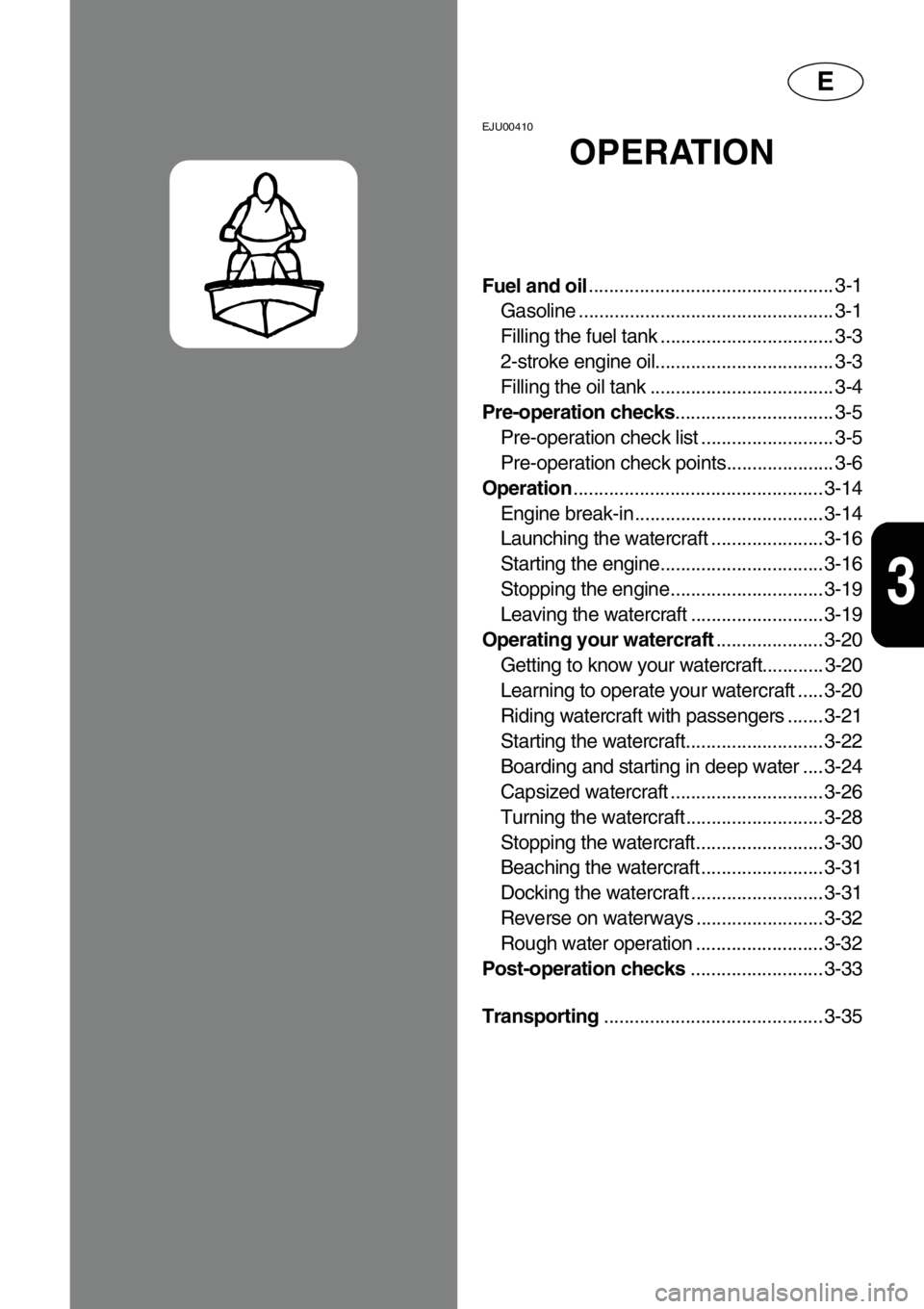
E
3
EJU00410
OPERATION
Fuel and oil................................................ 3-1
Gasoline .................................................. 3-1
Filling the fuel tank .................................. 3-3
2-stroke engine oil................................... 3-3
Filling the oil tank .................................... 3-4
Pre-operation checks............................... 3-5
Pre-operation check list .......................... 3-5
Pre-operation check points..................... 3-6
Operation................................................. 3-14
Engine break-in ..................................... 3-14
Launching the watercraft ...................... 3-16
Starting the engine................................ 3-16
Stopping the engine.............................. 3-19
Leaving the watercraft .......................... 3-19
Operating your watercraft..................... 3-20
Getting to know your watercraft............ 3-20
Learning to operate your watercraft ..... 3-20
Riding watercraft with passengers ....... 3-21
Starting the watercraft........................... 3-22
Boarding and starting in deep water .... 3-24
Capsized watercraft .............................. 3-26
Turning the watercraft........................... 3-28
Stopping the watercraft......................... 3-30
Beaching the watercraft ........................ 3-31
Docking the watercraft .......................... 3-31
Reverse on waterways ......................... 3-32
Rough water operation ......................... 3-32
Post-operation checks.......................... 3-33
Transporting........................................... 3-35
Page 58 of 131
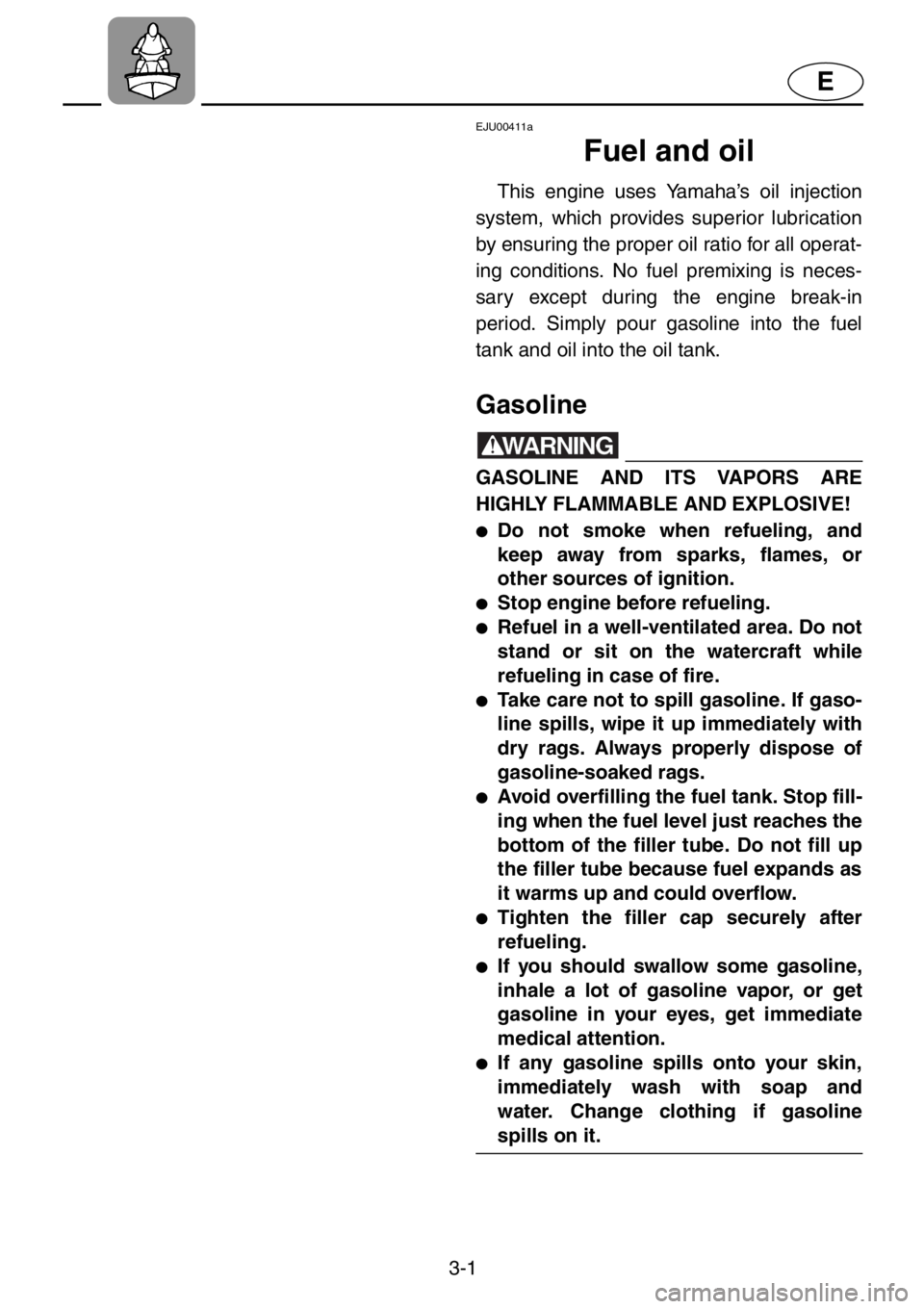
3-1
E
EJU00411a
Fuel and oil
This engine uses Yamaha’s oil injection
system, which provides superior lubrication
by ensuring the proper oil ratio for all operat-
ing conditions. No fuel premixing is neces-
sary except during the engine break-in
period. Simply pour gasoline into the fuel
tank and oil into the oil tank.
Gasoline
WARNING
GASOLINE AND ITS VAPORS ARE
HIGHLY FLAMMABLE AND EXPLOSIVE!
●Do not smoke when refueling, and
keep away from sparks, flames, or
other sources of ignition.
●Stop engine before refueling.
●Refuel in a well-ventilated area. Do not
stand or sit on the watercraft while
refueling in case of fire.
●Take care not to spill gasoline. If gaso-
line spills, wipe it up immediately with
dry rags. Always properly dispose of
gasoline-soaked rags.
●Avoid overfilling the fuel tank. Stop fill-
ing when the fuel level just reaches the
bottom of the filler tube. Do not fill up
the filler tube because fuel expands as
it warms up and could overflow.
●Tighten the filler cap securely after
refueling.
●If you should swallow some gasoline,
inhale a lot of gasoline vapor, or get
gasoline in your eyes, get immediate
medical attention.
●If any gasoline spills onto your skin,
immediately wash with soap and
water. Change clothing if gasoline
spills on it.
Page 60 of 131
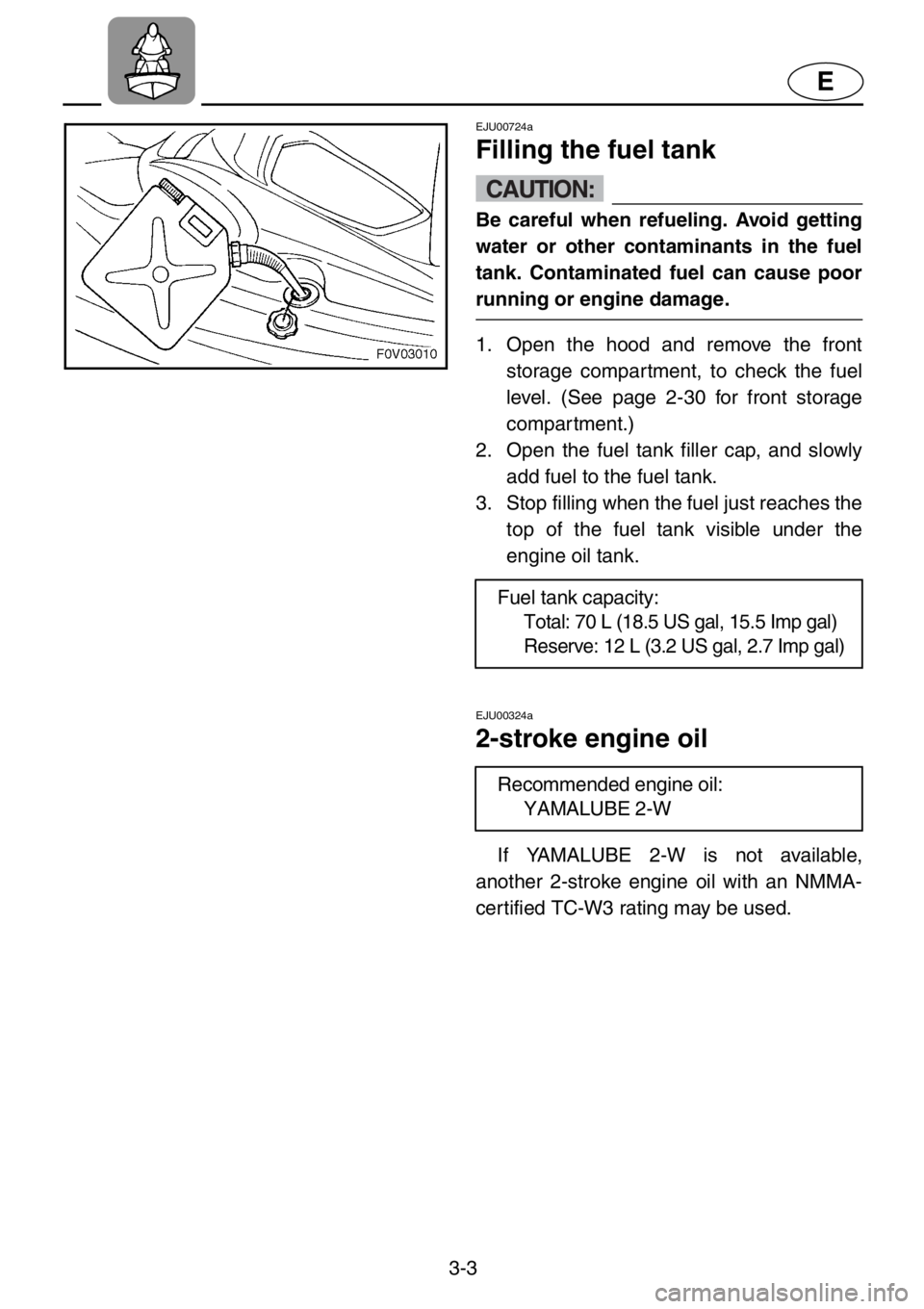
3-3
E
EJU00724a
Filling the fuel tank
CAUTION:
Be careful when refueling. Avoid getting
water or other contaminants in the fuel
tank. Contaminated fuel can cause poor
running or engine damage.
1. Open the hood and remove the front
storage compartment, to check the fuel
level. (See page 2-30 for front storage
compartment.)
2. Open the fuel tank filler cap, and slowly
add fuel to the fuel tank.
3. Stop filling when the fuel just reaches the
top of the fuel tank visible under the
engine oil tank.
EJU00324a
2-stroke engine oil
If YAMALUBE 2-W is not available,
another 2-stroke engine oil with an NMMA-
certified TC-W3 rating may be used.Fuel tank capacity:
Total: 70 L (18.5 US gal, 15.5 Imp gal)
Reserve: 12 L (3.2 US gal, 2.7 Imp gal)
Recommended engine oil:
YAMALUBE 2-W